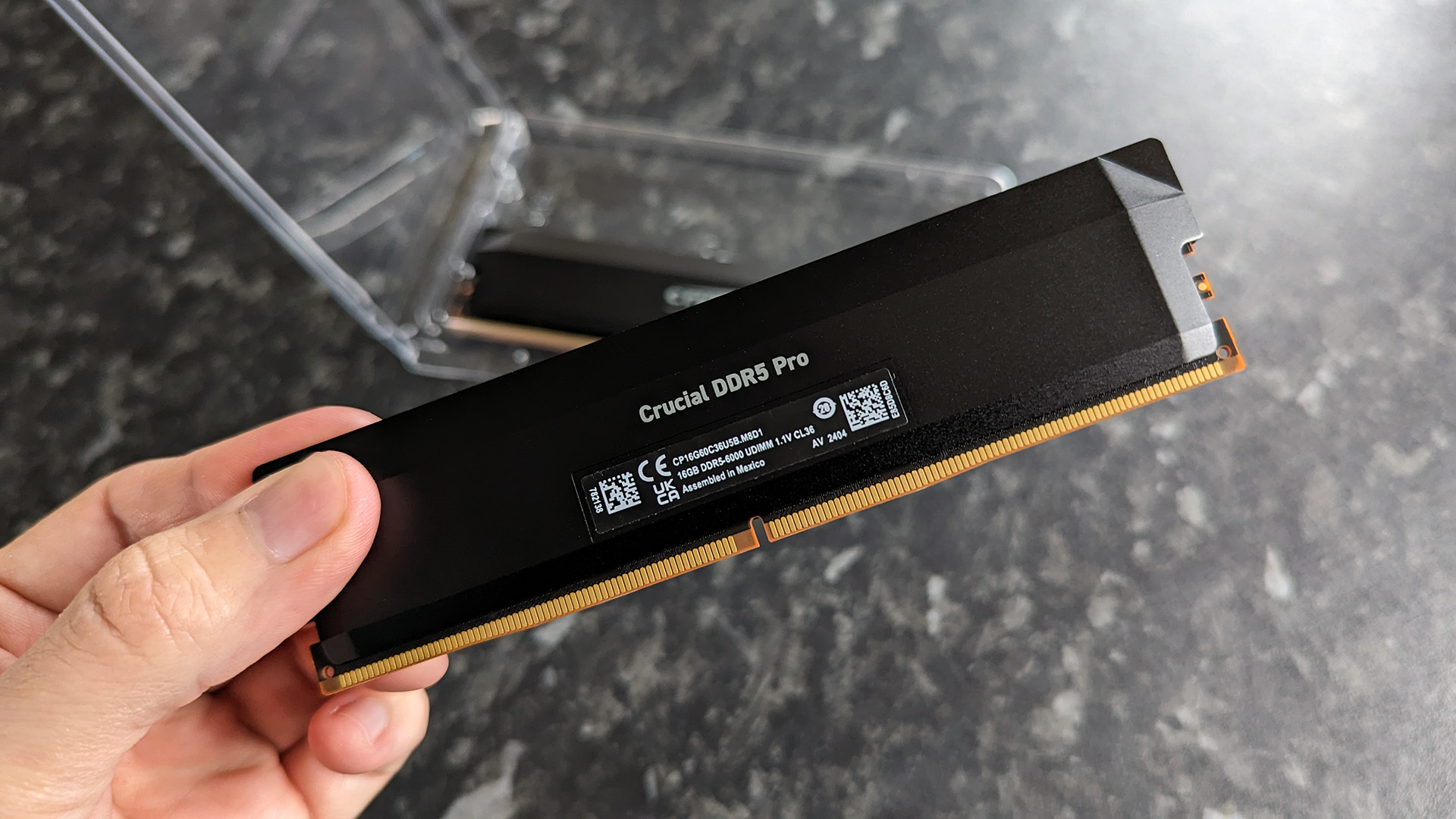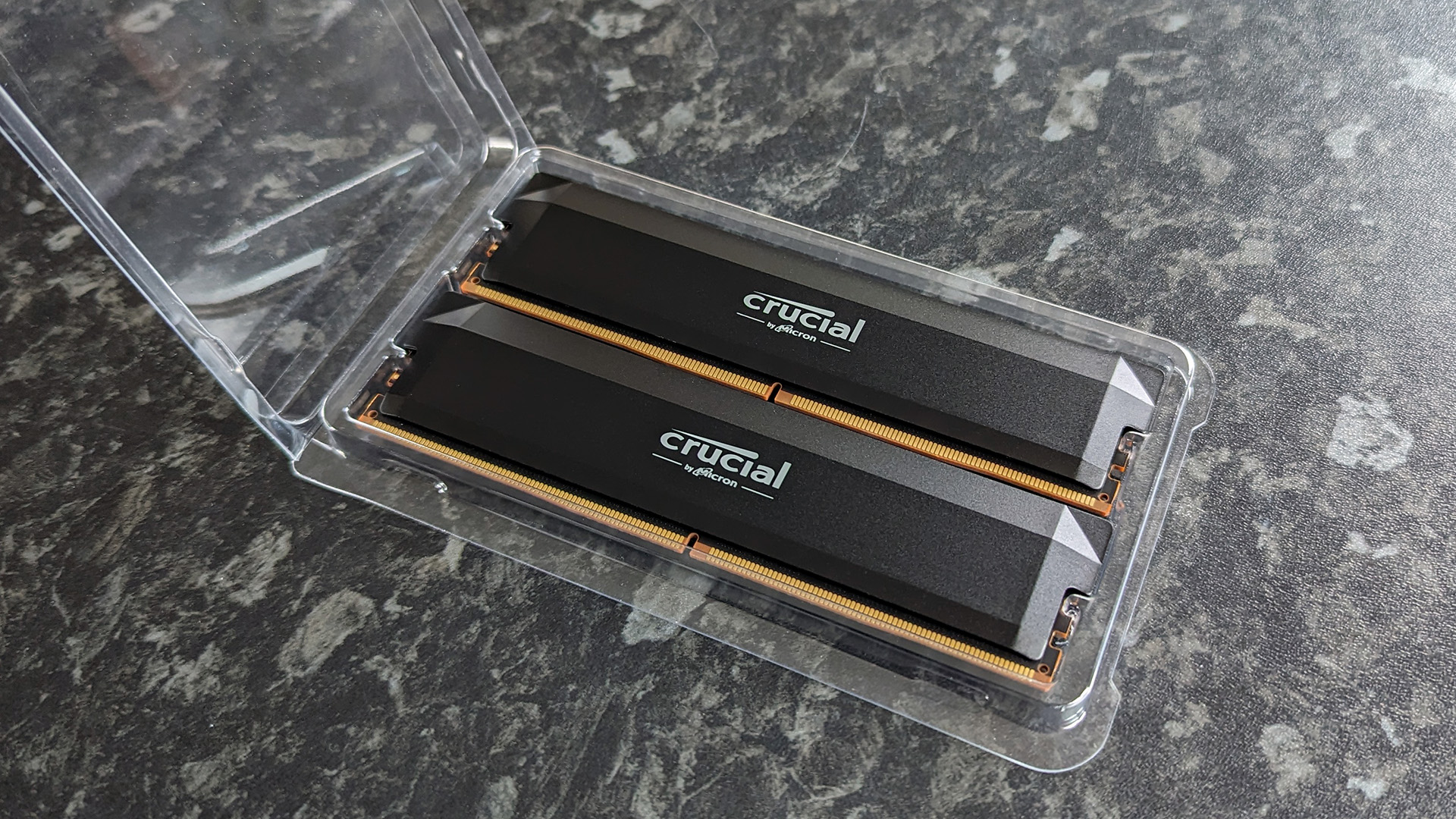Windows Central Verdict
Crucial skips the fancy rainbow effects of RGB and focuses on performance with its Pro Series Overclocking Edition RAM, clocked at the implied 6000MT/s 'sweet spot' for AMD Ryzen 7000 CPUs. In testing, it performed well with a Ryzen 7800X3D, but a lack of purchase options and stock at launch makes it harder to stand out against some competitors.
Pros
- +
6000MT/s is perfect for AMD 7000 CPUs.
- +
Cross-compatibility with Intel XMP and AMD EXPO.
- +
Decent performance with reasonable latency.
Cons
- -
Lacking availability for 32GB kits at launch.
- -
No RGB or any exciting design aesthetics for its price.
Why you can trust Windows Central
Recent updates
May 21, 2024: This review has been updated to reflect new availability: Crucial is selling variants with white heat spreaders, though other specifications remain the same.
Modern custom-built desktop PCs are gradually adopting DDR5 memory as the new standard, with more of a forceful move made by AMD, while Intel still allows DDR4 compatibility on 12th and 13th Gen Core processors. It's here to stay, and there are plenty to choose from, which makes it a little tricky when you don't know which specifications matter the most. Crucial is no stranger to the category and has expanded its range with more Pro Series RAM aimed at overclocking enthusiasts and gamers.
Disclaimer
This review was made possible with a review unit provided by Crucial. The company did not see the contents of the review before publishing.
Crucial Pro OC DDR5: Price and availability

Crucial sells its Pro Memory: Overclocking Edition series RAM through the official Crucial store and via major third-party retailers in the US, including Newegg, for $163.99 when choosing a 2x 24GB kit.
As of May 21, 2024, variants with a white heat spreader are available, starting at $153.99 for a 16GB kit. Besides the color, its specifications are unchanged but will better suit an all-white custom build.
Crucial Pro OC DDR5: Specifications



Shopping for desktop memory can feel like an ocean of jargon, and it's easy to be swept away in the specifications that don't matter to the average buyer. Highlighting the most important on the Crucial Pro Overclocking sets would involve the DDR5 generation, 6000MT/s maximum bandwidth, and 36-38-38-80 timings/latency running at 1.35V.
Besides those, support for Intel XMP and AMD EXPO profiles is what enables you to push the bandwidth over 5600MT/s, so you're covered for compatibility whether you build a custom desktop with an Intel Core 12th, 13th, or 14th Gen processor or an AMD Ryzen 7000 or 8000 alternative. I'm using a previously reviewed ASUS ROG STRIX B650-A Gaming WiFi motherboard and the high-scoring AMD Ryzen 7800X3D CPU for testing, so I'm relying on EXPO.
Crucial Pro OC DDR5: Overclocking

So the clue is the name of this RAM: the primary appeal is using Intel XMP 3.0 or AMD EXPO overclocking profiles to push for extra performance by exceeding the usual 5600MT/s bandwidth of DDR5 RAM. It's not a unique selling point, as most memory kits support straightforward overclocking. However, some beginner DIY builders could be forgiven for missing the requirement to activate the profile in their PC's BIOS.
Nevertheless, Crucial targets overclocking enthusiasts who tinker with their hardware and fine-tune as many aspects as their system allows, promising that its pre-installed heat spreader will help keep thermals under control. Crucial's team sent me 2x 32GB sets for 64GB, which is a little overkill for most people. I tested a single pair first, then installed all four sticks in each DIMM socket.

Using the advertised 6000MT/s EXPO profile, latency comes in at 71.7 ns (nanoseconds) for a single pairing of 32GB and 75.3 ns for four modules running 64GB. The supposed 'sweet spot' for AMD Ryzen 7000 CPUs is DDR5-6000 RAM just like this, and the results might seem like somewhat of a mixed bag in an AIDA64 benchmark test.
Write speeds up to 88GB/s with the 64GB setup is fantastic, while read and copy speeds around 59GB/s are less impressive, particularly on the 32GB side, though higher frequencies are implied to help with gaming.
DDR5 kits with shorter CL latency would push for higher read, write, and copy speeds but naturally push the price up. Without RGB or a particular focus on aesthetics, this Pro OC RAM is a no-frills solution for those looking to focus entirely on pushing for smoother framerates in PC games, precisely in line with Corsair's marketing. Whether or not it's worth buying comes down to its place in an increasingly aggressive market with plenty of brands and configurations to choose from as DDR5 becomes the norm.
Crucial Pro OC DDR5: The competition

Quick links
- G.Skill Ripjaws S5 32 GB | $99.99 on Amazon
- Corsair Vengeance 32 GB | $114.99 at Best Buy
- G.Skill Trident Z5 RGB 32 GB | $117.99 at Newegg
- Kingston FURY Beast RGB 32GB | $139.99 at Newegg
- CORSAIR VENGEANCE DDR5 RAM 48GB | $164.99 at Amazon
While it's great to see RAM compatible with both Intel XMP and AMD EXPO overclocking profiles in theory, you'll rarely need both unless you're harvesting parts for a future build where you swap CPU teams later down the road.
If we're discarding RGB, there are a couple of picks for DDR5-6000 RAM with CAS 36 timings to choose from. G.Skill Ripjaws S5 32 GB sells for around $99.99 on Amazon and supports XMP for Intel processors, while the ever-classic Corsair Vengeance 32 GB sells for $114.99 at Best Buy and supports EXPO for AMD.
However, pretty rainbow lights regularly and easily influence me, so I'd spring for G.Skill Trident Z5 RGB 32 GB for $117.99 at Newegg if I were building an Intel XMP system or Kingston FURY Beast RGB 32GB for $139.99 at Newegg for an AMD EXPO build and enjoy the customizable RGB.
Naturally, these are all 32GB kit recommendations, and that still isn't the most popular option, a throne still held by 16GB kits. If you want a 2x 24GB kit, check out Corsair's Vengeance 48GB for $164.99 at Amazon.
Crucial Pro OC DDR5: Should you buy?

You should buy this if ...
✅ You're building a custom AMD gaming PC
DDR5-6000 RAM is just about perfect for AMD Ryzen 7000 CPUs, as confirmed by its technical marketing team. Crucial has your back for XMP on Intel Core 12th, 13th, and 14th Gen CPUs, too, if you're Team Blue.
You should avoid this if ...
❌ You want RGB gamer aesthetics
While they're geared for bandwidth, these modules are about as plain as it gets. The heatsinks are functional but not exciting in the slightest.
Not everyone loves RGB, and that's fine. Pure performance is regularly a focus for custom builders, and flashing rainbow lights can be something you grow out of. For that category, Crucial offers a solid solution for anyone building a desktop with Intel or AMD. Cross-compatibility with XMP and EXPO overclocking profiles helps it appeal to a broader audience, while the gaming-centric crowd who want maximum potential framerates will appreciate the 6000MT/s bandwidth, making it some of the best RAM for AMD Ryzen 7000 CPUs.

Ben is a Senior Editor at Windows Central, covering everything related to technology hardware and software. He regularly goes hands-on with the latest Windows laptops, components inside custom gaming desktops, and any accessory compatible with PC and Xbox. His lifelong obsession with dismantling gadgets to see how they work led him to pursue a career in tech-centric journalism after a decade of experience in electronics retail and tech support.



